Fentanyl Mylan 12 micrograms / hour transdermal patch Fentanyl Mylan 25 micrograms / hour transdermal patch Fentanyl Mylan 50 micrograms / hour transdermal patch Fentanyl Mylan 75 micrograms / hour transdermal patch Fentanyl Mylan 100 micrograms / hour transdermal patch
fentanyl
What Fentanyl Mylan is and what it is used for
The name of your medicine is Fentanyl Mylan.
The patches relieve very severely and long-lasting pain:
- in adults who need continuous pain treatment
- in children over 2 years of age who are already using opioid medicines and need continuous pain treatment.
Fentanyl Mylan contains a medicine called fentanyl . It belongs to a group of strong painkillers called opioids.
Fentanyl contained in Fentanyl Mylan may also be approved for the treatment of other diseases not mentioned in this product information. Ask your doctor, pharmacist, or another healthcare professional if you have any further questions, and always follow their instructions.
What you need to know before you use Fentanyl Mylan
Do not use Fentanyl Mylan
- if you are allergic to fentanyl or any of the other ingredients of this medicine (listed in section 6).
- if you suffer from pain that lasts only a short period of time, such as sudden pain or pain after a surgical procedure
- if you have difficulty breathing with slow or shallow breathing.
Do not use this medicine if any of the above apply to you or your child. If you have any further questions, ask your doctor or pharmacist before using Fentanyl Mylan.
Warnings and cautions
- Fentanyl Mylan can cause life-threatening side effects in people who are not already regularly taking prescription opioid medicines.
- Fentanyl Mylan is a drug that can be life-threatening for children. This also applies to used patches. Keep in mind that a self-adhesive patch (unused or used) can be attractive to a child and if the patch sticks to the child’s skin or if the child puts it in his mouth, it can be fatal.
Depot patches that have adhered to another person
The patch should only be used on the skin of the person prescribed by the doctor. There are reported cases where a patch was accidentally stuck to a family member during close physical contact or when a bed was shared with the wearer of the patch. A patch that has adhered to another person (especially a child) can cause drugs to pass through the other person’s skin and cause serious side effects such as difficulty breathing with slow and shallow breathing, which can be fatal. If the patch has adhered to another person’s skin, remove the patch immediately and consult a physician.
Take special care with Fentanyl Mylan
Talk to your doctor or pharmacist before using this medicine if any of the following apply to you – your doctor may need to examine you more carefully about:
- Have you ever had problems with your lungs or breathing?
- Have you ever had problems with your heart, liver, kidneys, or had low blood pressure?
- You’ve ever had a brain tumor
- Have you ever had a prolonged headache or a head injury
- You are older – you may be more sensitive to the effects of this medicine
- You have a disease called myasthenia gravis when the muscles become weak and tired quickly
- Have you ever abused or been addicted to alcohol, prescription drugs, or illegal drugs.
If any of the above apply to you (or you feel unsure), talk to your doctor or pharmacist before using Fentanyl Mylan.
Side effects and Fentanyl Mylan
- Fentanyl Mylan can make you unusually sleepy and cause you to breathe more slowly and shallowly. In very rare cases, these breathing problems can be life-threatening or even fatal, especially in people who have never used strong painkillers with opioids (such as Fentanyl Mylan or morphine). If you or your partner or caregiver notice that the person wearing the patch is unusually sleepy and is breathing slowly or shallowly:
- Remove the patch
- Call a doctor or go to the nearest hospital immediately
- Make sure the person is moving and talking as much as possible
- If you get a fever while using Fentanyl Mylan, tell your doctor – it may cause an increased amount of medicine to pass through your skin.
- Fentanyl Mylan can cause constipation. Consult a doctor or pharmacist for help in preventing or treating constipation.
- Repeated, long-term treatment with the patches may make the medicine less effective (you will become “tolerant” of it) or make you addicted to it.
See section 4 for a complete list of possible side effects.
When wearing the patch, do not expose it to direct heat, such as heating pads, electric blankets, hot water bottles, heated water beds, or heat or sun lamps. You should not sunbathe, take long hot baths, bathe or take hot whirlpool baths. If you do this, you may get an increased amount of medication from the patch.
Other medicines and Fentanyl Mylan
Tell your doctor or nurse if you are taking, have recently taken, or might take any other medicines. This also applies to over-the-counter medicines and herbal medicines. You should also tell the pharmacy staff that you are using Fentanyl Mylan if you buy any medicines at the pharmacy.
Your doctor will know which medicines are safe to take with Fentanyl Mylan. If you are taking any of the types of medicines listed below or if you stop taking any of these, you may need to be closely monitored as it may affect the dose of FentanylMylan you need.
Above all, tell your doctor or pharmacist if you are taking:
- Other analgesics such as smärtillande drugs with opioid ‘s (such as buprenorphine, nalbuphine or pentazocine)
- Medicines to help you sleep (such as temazepam, zaleplon, or zolpidem)
- Medicines that make you feel calmer (sedatives such as alprazolam, clonazepam, diazepam, hydroxyzine, or lorazepam) and medicines for mental problems (antipsychotics such as aripiprazole, haloperidol, olanzapine, risperidone, or phenothiazines)
- Muscle relaxants (such as cyclobenzaprine or diazepam )
- Some medicines used to treat depression, called SSRIs or SNRIs (such as citalopram, duloxetine, escitalopram, fluoxetine, fluvoxamine, paroxetine, sertraline, or venlafaxine ) – see below for more information
- Some medicines for depression or Parkinson’s disease called MAO inhibitors(such as isocarboxazid, phenelzine, selegiline, or tranylcypromine). You should not take Fentanyl Mylan within 14 days of stopping these medicines – see below for more information
- Some antihistamines, especially those that make you sleepy (such as chlorpheniramine, clemastine, cyproheptadine, diphenhydramine, or hydroxyzine)
- Some antibiotics used for infection (such as erythromycin or clarithromycin)
- Medicines for fungal infections (such as itraconazole, ketoconazole , fluconazoleor voriconazole)
- Drugs for HIV – infection’s (such as ritonavir)
- Drugs for irregular heartbeat (such as amiodarone, diltiazem, or verapamil)
- Medicines for tuberculosis (such as rifampicin)
- Some medicines for epilepsy (such as carbamazepine, phenobarbital, or phenytoin)
- Some medicines for nausea or motion sickness (such as phenothiazines)
- Some medicines for heartburn or stomach ulcers (such as cimetidine)
- Some medicines for angina (chest pain) or high blood pressure (such as nicardipine)
- Some medicines are used to treat blood cancer (such as idelalisib).
Fentanyl Mylan with antidepressants
The risk of side effects is increased if you take medicines such as certain medicines for depression. Fentanyl Mylan can interact with these drugs and you may experience that your mental status changes so that you, for example, feel anxious or see, feel, hear or feel the smell of something that does not exist (hallucinations) and experience other effects such as altered blood pressure, rapid heartbeat, high body temperature, overactive reflexes, lack of coordination, muscle stiffness, nausea, vomiting, and diarrhea.
Use with medicines that suppress the central nervous system, including alcohol and certain narcotic drugs
Tell your doctor if you are taking other medicines that suppress your central nervous system ( CNS depressants). CNS depressants are, for example, drugs that make you sleep, alleviate anxiety, or diminish attention (see also “Other drugs and FentanylMylan”). Alcohol and certain narcotic drugs also suppress the central nervous system. Taking these types of medicines along with Fentanyl Mylan can cause severe drowsiness, impaired attention, difficulty breathing with slow or shallow breathing, coma, and death. Do not drink alcohol while using FentanylMylan if you have not consulted your doctor first. Operations If you think you may be anesthetized/anesthetized, tell your doctor or dentist that you are using Fentanyl Mylan.
Pregnancy and breastfeeding
If you are pregnant or breast-feeding, think you may be pregnant, or are planning to have a baby, ask your doctor or pharmacist for advice before taking this medicine.
Fentanyl Mylan should not be used during pregnancy unless you have first discussed this with your doctor.
Fentanyl Mylan should not be used during childbirth, as it may affect the breathing of the newborn baby.
Do not use Fentanyl Mylan if you are breast-feeding. You should not breast-feed for 3 days after removing the Fentanyl Mylan transdermal patch. The reason for this is that the drug can pass into breast milk.
Driving and using machines
Fentanyl Mylan may affect your ability to drive and use machines or tools as it may make you drowsy or dizzy. If this happens, do not drive or use any tools or machines. Do not drive while using this medicine until you know how it affects you.
If you are not sure if it is safe for you to drive a vehicle while you are taking this medicine, talk to your doctor or pharmacist.
You are responsible for assessing whether you are fit to drive a motor vehicle or perform work that requires sharpened attention. One of the factors that can affect your ability in these respects is the use of drugs due to their effects and/or side effects. Descriptions of these effects and side effects can be found in other sections. Read all the information in this leaflet for guidance. If you are not sure, talk to your doctor or pharmacist.
3. How to use Fentanyl Mylan
Always use this medicine exactly as your doctor has told you. Ask your doctor or pharmacist if you are unsure.
Your doctor will decide which strength of Fentanyl Mylan is most suitable for you. The doctor bases his assessment on how severe your pain is, your general condition, and the type of pain treatment you have received so far.
Use and change patches
- There is enough medicine in each patch to last for 3 days (72 hours).
- You should change your patch every three days unless your doctor has told you otherwise.
- Always remove the old patch before applying the new one.
- Always change patches at the same time of day every three days (72 hours).
- If you use more than one patch, change all patches at once.
- Write down the day, date, and time you put on the patch, so you know when you need to change your patch.
- The following table shows you when it is time to change patches:
| Put on your patch at | Change your patch on | |
| Monday | Thursday | |
| Tuesday | Friday | |
| Wednesday | Saturday | |
| Thursday | Sunday | |
| Friday | Monday | |
| Saturday | Tuesday | |
| Sunday | Wednesday |
Here you put on the patch
Adults
- Apply the patch on a flat part of your upper body or arm (not over a joint).
Children
- Always put the patch on the upper back so that the child does not have access to or remove the patch.
- Check from time to time if the patch remains on the skin.
- Your child mustn’t take the patch and put it in his mouth as it can be life-threatening and even fatal.
- Observe your child very closely for 48 hours after:
- The first patch has been applied
- A higher dose patch has been applied.
- It may take some time for the patch to take full effect. Therefore, your child may also need to take other painkillers before the patches take effect. Your doctor will talk to you about this.
Adults and children:
Do not attach the patch
- The same place twice in a row
- Skin surfaces that move a lot (joints), skin that is irritated or has sores
- Skin with a lot of hair. If there is hair, do not shave it off (shaving irritates the skin). Instead, cut the hair as close to the skin as possible.
Put on a patch
Step 1: Prepare the skin
- Make sure the skin is completely dry, clean, and cool before applying the patch.
- If you need to clean your skin, use only cold water.
- Do not use soap or other detergents, creams, moisturizing lotions, oils, or talcum powder before applying the patch.
- Do not apply a patch immediately after a hot bath or shower.
Step 2: Open the bag
- Each patch is enclosed in a separate bag.
- Open the bag by first making a small cut near the sealed edge of the bag using the tip of a pair of scissors (Figure 1).
Figure 1:
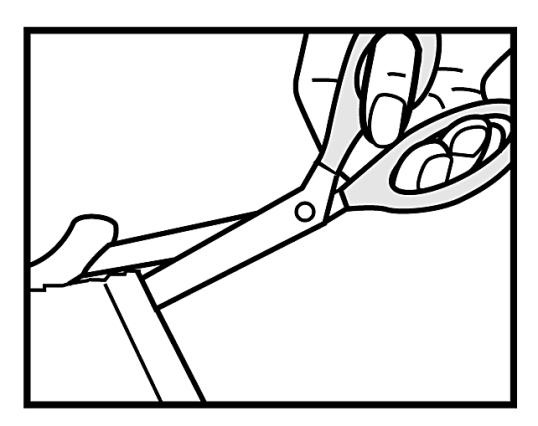
- Carefully tear open the bag by hand completely (figure 2).
Figure 2:
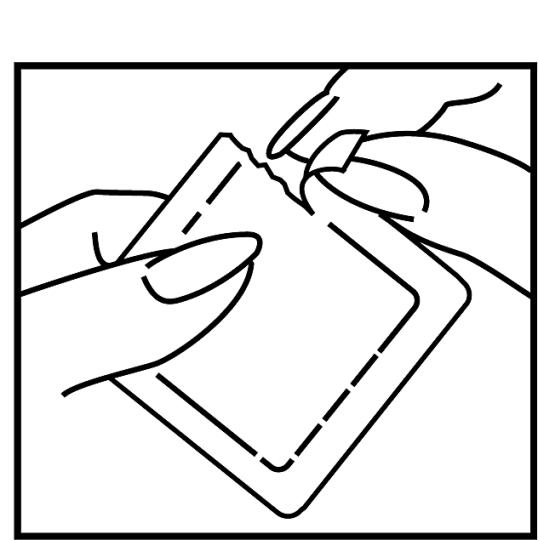
- Grasp both sides of the opened bag and pull them apart so that three sides of the bag are open, removing the patch (Figure 3).
Figure 3:
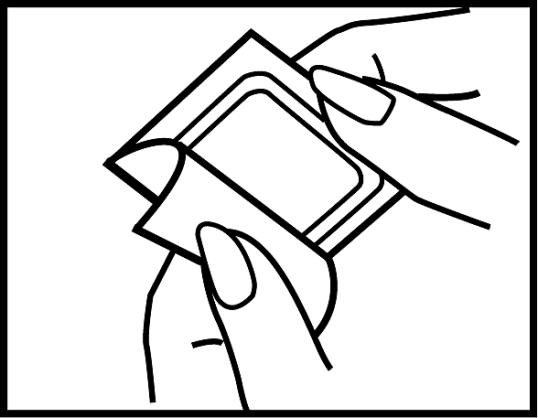
- Remove the patch and apply it immediately (figure 4).
Figure 4:
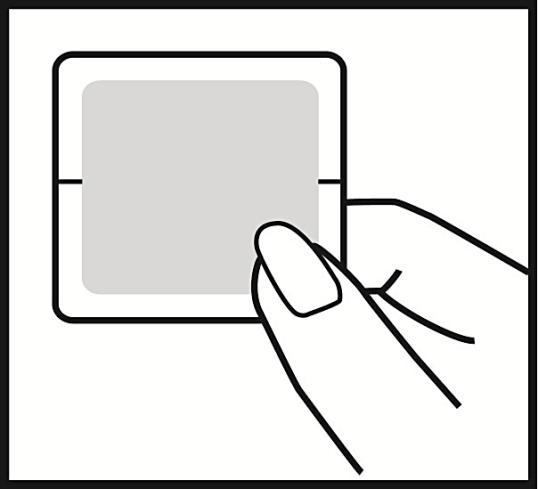
- Save the empty bag so that you can put your used patch in the latter when the patch is to be thrown away.
- Each patch should only be used once.
- Do not remove the patch from the bag until you are ready to use it.
- Check that the patch is not damaged.
- Do not use the patch if it has been split, cut, or looks damaged.
- Never divide or cut the patch.
Step 3: Remove and press
- Make sure that the patch will be covered by loose clothing and that it will not sit under a tight or elastic band.
- Attach the patch as soon as the package has been opened, once the protective film has been removed. Carefully pull one-half of the clear protective film away from the center of the patch. Avoid touching the adhesive side of the patch (Figure 5).
Figure 5:
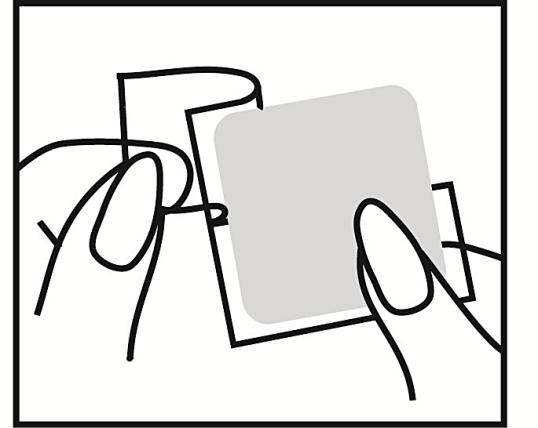
- Press this adhesive part of the patch against the skin (Figure 6).
Figure 6:
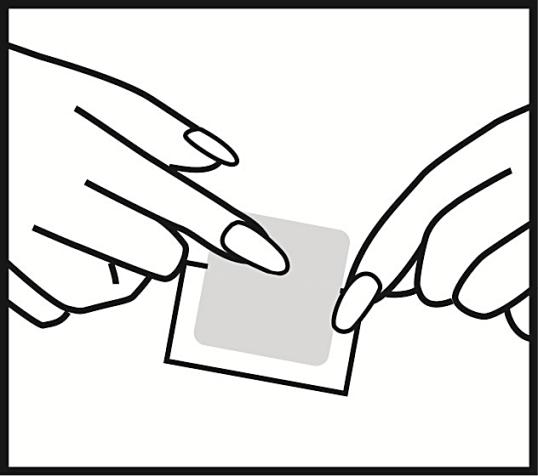
- Remove the second part of the clear protective film (Figure 7).
Figure 7:
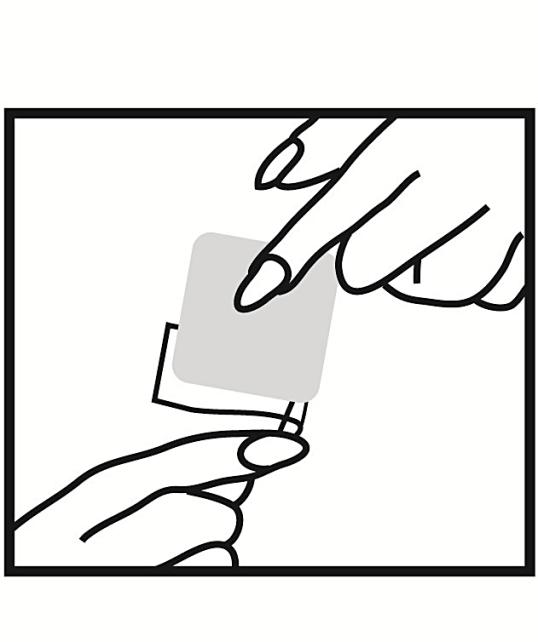
- Press the entire patch against the skin with the palm of your hand.
- Press for at least 30 seconds. Make sure that the patch adheres well to the skin, especially at the edges (figure 8).
Figure 8:
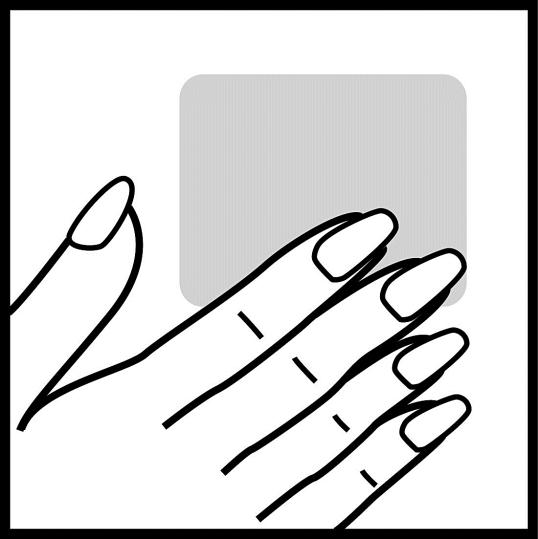
Step 4: Discard the patch
- As soon as you remove the patch, fold it carefully in the middle so that the adhesive side sticks together.
- Put it back in its original bag and discard the bag according to the instructions of the pharmacy staff.
- Keep used patches out of the reach and sight of children – even used patches contain some medicines that can harm children and can even be fatal.
Step 5: Wash
- Always wash your hands with clean water only after handling the patch.
More about using Fentanyl Mylan
Everyday activities when the patch is used
- The patches are water-resistant.
- You can shower or bathe while wearing the patch, but do not rub on the patch itself.
- If your doctor agrees, you can exercise and participate in sports activities while wearing the patch.
- You can also swim while wearing the patch, but:
- Do not bathe in hot tubs.
- Do not apply tight or elastic bands over the patch.
- When wearing the patch, do not expose it to direct heat, such as heating pads, electric blankets, hot water bottles, heated water beds, or heat or sun lamps. You should not sunbathe, take long hot baths or take a sauna. If you do this, you may get an increased amount of medication from the patch.
How quickly do the patches take effect?
- It may take some time for your first patch to take full effect.
- Your doctor may also give you other painkillers for the first day.
- After that, the patch should relieve the pain continuously so that you can stop taking other painkillers, but your doctor may prescribe other painkillers from time to time.
How long will you use the patches?
- Fentanyl Mylan patches are intended for long-lasting pain. Your doctor can tell you how long you can expect to use the patches.
If your pain worsens
- If your pain worsens while you use the patches, your doctor may try to give you patches with higher strength or additional painkillers (or both).
- If it does not help to increase the strength of the patches, your doctor may stop using the patches.
If you use too many patches or patches with the wrong strength
If you have ingested too much medicine or if e.g. If a child has inadvertently ingested the medicine, contact a doctor, hospital, or the Poison Information Center for risk assessment and advice.
If you have applied too many patches or patches with the wrong strength, remove the patches and contact a doctor immediately.
Signs of overdose include difficulty breathing or shallow breathing, fatigue, extreme drowsiness, inability to think clearly, walk or speak normally, lethargy, dizziness, and confusion.
If you forget to change your patch
- If you forget to change your patch, do it as soon as you can and write down the day and time. Change the patch again after 3 days (72 hours) as usual.
- If you are very late in changing your patch, talk to your doctor, as you may need more painkillers, but do not put on an extra patch.
If a patch comes off
- If a patch comes off before it is time to change, immediately apply a new one and write down the day and time. Apply a new skin surface on:
- Your upper body or arm
- The upper part of your baby’s back.
- Let your doctor know that this has happened and leave the patch on for another 3 days (72 hours), or the time specified by your doctor, before changing to a new patch as usual.
- If your patches constantly come off, talk to a doctor, pharmacist, or nurse.
If you want to stop using the patches
- Talk to your doctor before stopping using these patches.
- If you have been using them for a long time, your body may have become accustomed to them. If you suddenly quit, you may start to feel unwell.
If you stop using the patches, do not start again without first asking your doctor. You may need a different strength of the patches when you start again.
If you have any further questions on the use of this product, ask your doctor or pharmacist.
4. Possible side effects
Like all medicines, this medicine can cause side effects, although not everybody gets them.
If you or your partner or caregiver notice any of the following in the person using the patch, remove the patch and contact a doctor or go to the nearest hospital immediately. The person may need immediate medical attention.
- Unusual drowsiness, slower or shallower breathing than expected. Follow the advice above and make sure the person using the patch moves and talks as much as possible. In very rare cases, these breathing difficulties can be life-threatening or even fatal, especially in people who have never used strong painkillers with opioids (such as Fentanyl Mylan or morphine). (Uncommon, may affect up to 1 in 100 people)
- Sudden swelling of the face or throat, severe irritation, redness, or blistering of your skin. This may be a sign of an allergic reaction. (Has been reported, occurs in an unknown number of users)
- Seizures. (Uncommon, may affect up to 1 in 100 people.)
- Decreased level of consciousness or loss of consciousness. (Uncommon, may affect up to 1 in 100 people.)
The following side effects have also been reported
Very common (may affect more than 1 in 10 people)
- Nausea, vomiting, constipation
- Sleepiness ( somnolence )
- Dizziness
- Headache
Common (may affect up to 1 in 10 people)
- Allergic reaction
- Loss of appetite
- Difficulty sleeping
- Depression
- The feeling of anxiety and confusion
- To see, feel, hear or smell something that does not exist (hallucinations)
- Shaking or muscle twitching
- Abnormal sensation in the skin, such as tingling or crawling sensation ( paresthesias )
- Dizziness (fraud)
- Rapid or irregular heartbeat ( palpitation, tachycardia )
- High blood pressure
- Shortness of breath ( dyspnoea )
- Diarrhea
- Dry mouth
- Abdominal pain or indigestion
- Significantly increased sweating
- Itching, rash, or redness of the skin
- Inability to urinate or empty bladder properly
- Severe fatigue, weakness, or general malaise
- To feel frozen
- Swollen hands, ankles, or feet (peripheral edema ).
Uncommon (may affect up to 1 in 100 people)
- Feeling anxious or confused
- A strong feeling of happiness ( euphoria )
- Decreased sensation or sensitivity, especially in the skin ( hypoesthesia )
- Memory loss
- Dimsyn
- Slow heartbeat ( bradycardia ) or low blood pressure
- Blue skin caused by low oxygen content in the blood (cyanosis)
- Intestinal cramps ( ileus )
- Itchy skin rash ( eczema ), an allergic reaction, or other skin conditions where the patch is located
- Flu-like illness
- The feeling of change in body temperature
- Fever
- Muscle twitching
- Difficulty getting and maintaining an erection ( impotence ) or problems having sex
Rare side effects (may affect up to 1 in 1,000 people)
- Condensed pupils are ( mios )
- Temporary respiratory arrest ( apnea )
Has been reported (occurs in an unknown number of users)
- Lack of male sex hormone (androgen deficiency)
- Delirium (symptoms may include a combination of agitation, restlessness, inability to orientate in the room, confusion, fear, seeing and hearing things that do not exist, sleep disturbances, nightmares)
You may notice a rash, redness, or slight itching in the skin where the patch is located. This is usually mild and disappears once you have removed the patch. If it does not disappear or if the patch irritates the skin very much, tell your doctor.
Repeated, long-term treatment with the patches may make the medicine less effective (you will become “tolerant” of it) or make you addicted to it.
If you switch from another painkiller to Fentanyl Mylan or if you suddenly stop using Fentanyl Mylan, you may experience withdrawal symptoms such as nausea, diarrhea, anxiety, or shaking. Tell your doctor if you get any of these symptoms.
There are also reports of newborns experiencing withdrawal symptoms after their mothers have been using Fentanyl Mylan for a long time during pregnancy.
5. How to store Fentanyl Mylan
Storage space
Keep all patches (used and unused) out of the reach and sight of children.
Storage time
Use Fentanyl Mylan before the expiry date which is stated on the carton and sachet after EXP. The expiration date is the last day of the specified month. If the patches have passed their expiry date, take them to your pharmacist.
This medicine does not require any special storage instructions.
How to dispose of used patches or patches you no longer need
If a used or unused patch is accidentally stuck on another person, especially a child, it can be fatal.
Used patches should be folded so that the adhesive side of the patch is glued together. Then put it back in the original bag and keep it out of sight and reach of other people, especially children, until it is disposed of safely. Ask your pharmacist how to dispose of medicines no longer required.
Medicines should not be disposed of via wastewater or household waste. These measures will help to protect the environment.
6. Contents of the packaging and other information
What Fentanyl Mylan contains
The active substance is fentanyl.
Each Fentanyl Mylan 12 microgram/hour transdermal patch contains 2.1 mg of fentanyl in a 5.25 cm 2 patch and releases 12.5 micrograms of fentanyl/hour (the strength is described as 12 micrograms/hour but the release rate of the patch is 12.5 micrograms /hour).
Each Fentanyl Mylan 25 microgram / hour transdermal patch contains 4.2 mg of fentanyl in a 10.5 cm 2 patch and releases 25 micrograms of fentanyl / hour.
Each Fentanyl Mylan 50 microgram / hour transdermal patch contains 8.4 mg of fentanyl in a 21cm2 patch that releases 50 micrograms of fentanyl / hour.
Each Fentanyl Mylan 75 microgram / hour transdermal patch contains 12.6 mg of fentanyl in a patch that is 31.5 cm2 and releases 75 micrograms of fentanyl / hour.
Each Fentanyl Mylan 100 microgram / hour transdermal patch contains 16.8 mg of fentanyl in a 42 cm2 patch that releases 100 micrograms of fentanyl / hour.
Other ingredients are:
Polyacrylate adhesive, siliconized polyester film (protective layer), polyethylene terephthalate/ethylene vinyl acetate film (protective film), and white ink.
What the medicine looks like and the contents of the pack
Fentanyl Mylan is a rectangular transparent plaster with white ink on a removable cover.
The following is printed on each patch:
Fentanyl 12 /g / h
Fentanyl 25 /g / h
Fentanyl 50 /g / h
Fentanyl 75 /g / h
Fentanyl 100 /g / h
The patch is covered with a transparent protective film that is removed before application to expose the adhesive backing so that it can adhere to the skin.
The patches are available in individually heat-sealed bags that are packed in a carton.
Fentanyl Mylan is available in pack sizes of 3, 4, 5, 8, 10, 16, and 20 transdermal patches, respectively.
Not all pack sizes may be marketed.
Manufacturer
McDermott Laboratories Ltd. trading as Gerard Laboratories
35/36 Baldoyle Industrial Estate
Grange Road
Dublin 13
Ireland
and
Generics [UK] Limited
Station Close
Potters Bar
Hertfordshire
EN6 1TL
UK